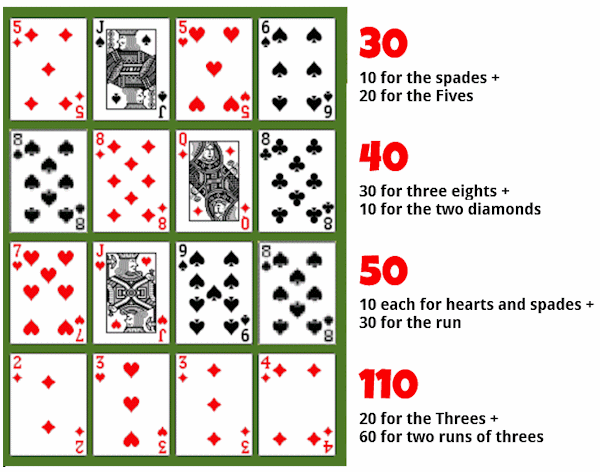Copyright
- Start
- Whoever cuts the highest card deals first. The turn to deal and play passes always to the left. Deal 13 cards each in batches of 3-3-3-1.
- Object
- To avoid winning tricks, and especially tricks containing matches. A match is two or more cards of the same rank or suit (pairs or flushes), or three or more cards in numerical order (runs). Penalties are scored for winning tricks and matches, so the eventual winner is the player with the lowest penalty score.
- Play
-
Dealer's left-hand neighbour leads to the first trick and the winner of each
trick leads to the next. You can play any card you like to a trick, but will
want to avoid matching the rank or suit of any card already played to it, or
(when playing third or fourth) completing a run of three or four.
If the trick does not contain a match, it is taken by the
highest card played, and its penalty score is that of the lowest card played,
which will be anything from 2 to 10. If you win such a trick, you place its
lowest card face up on the table before you to show your penalty score, and
throw the other three face down to a common waste-pile.
If the trick does contain a match, it is won by the last
player to duplicate a rank or suit, or to complete a run of three or four.
(Ace counts high or low in a run, i.e. A-K-Q or A-2-3.) Its penalty value is
a multiple of 10 as follows:
10 for two of the same suit
Each and every match contained in a trick you win counts against you, even any to which you didn't personally contribute. For each 10 involved, place any card from the trick face down on the table before you and discard the rest to a common waste-pile. If the penalty is 50 or more, take as many extra cards as you need from the waste-pile.
20 for two of the same rank (pair)
30 for three of the same rank or suit, or a run of three
40 for four of the same rank or suit, or a run of four - Score
- At end of play your penalty score is the total face values of all the numeral cards lying face up in your penalty pile, plus 10 for each penalty card lying face down.
- Game
- The overall winner is the player with the lowest penalty score at the end of eight deals, or when one player has reached 250 in penalties. (Or any other previously agreed number of deals or points.)
- Examples of scoring
- The penalty value of each of these four tricks is as follows:

Deal 13 cards each and set the remaining 26 face down as a stock. Each player plays two cards per trick, the player on lead leading to the first and third of them and the other to the second and fourth. Follow the same rules as for four players, but after each trick each player draws two cards from the stock (or one when only one remains) and adds it to their hand. When no cards remain in stock the remainder are played out to a conclusion.

